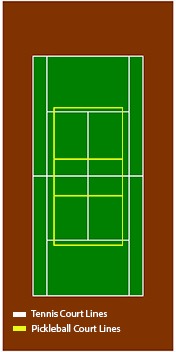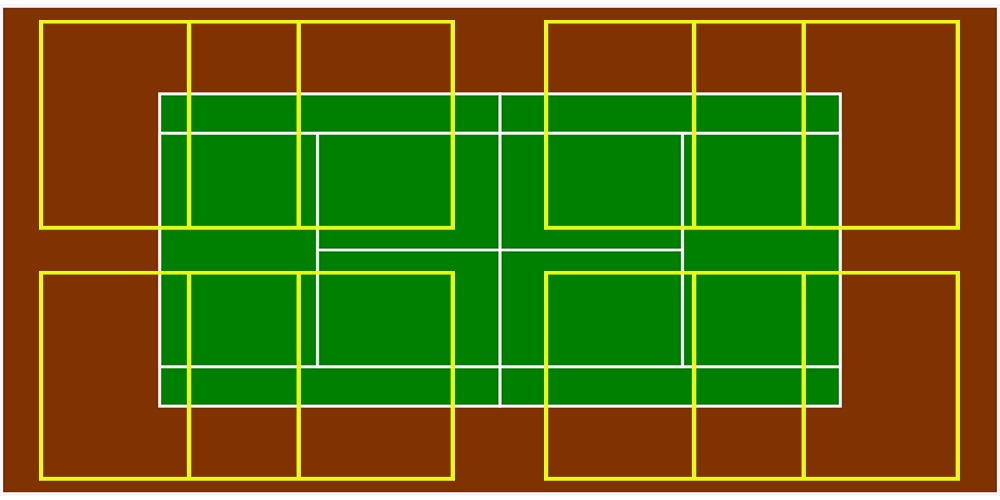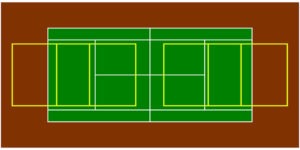 With approximately 100,000 players in the U.S., pickleball is one of the fastest growing sports. The increasing popularity of the sport has put pressure on communities to provide pickleball courts, which are generally installed on tennis courts. The growing demand by pickleball players, as well as the demand from tennis players, in communities, exceeds the supply of courts available.
With approximately 100,000 players in the U.S., pickleball is one of the fastest growing sports. The increasing popularity of the sport has put pressure on communities to provide pickleball courts, which are generally installed on tennis courts. The growing demand by pickleball players, as well as the demand from tennis players, in communities, exceeds the supply of courts available.
Communities have been exploring conversion options that will satisfy pickleball players while not interrupting the demand for courts by tennis players. A conversion trend by communities over the past few years has been to convert underutilized tennis courts to permanent pickleball courts. Although both tennis and pickleball players would prefer a tennis-specific or pickleball-specific court, another conversion trend that communities have utilized is to provide a multipurpose court that includes lines for tennis and pickleball.
With approximately 100,000 players in the U.S., pickleball is one of the fastest-growing sports. The increasing popularity of the sport has put pressure on communities to provide pickleball courts, which are generally installed on tennis courts. The growing demand by pickleball players, as well as the demand from tennis players, in communities, exceeds the supply of courts available.
Transitioning Tennis Courts into Pickleball Paradises
Communities have been exploring conversion options that will satisfy pickleball players while not interrupting the demand for courts by tennis players. A conversion trend by communities over the past few years has been to convert underutilized tennis courts to permanent pickleball courts. Although both tennis and pickleball players would prefer a tennis-specific or pickleball-specific court, another conversion trend that communities have utilized is to provide a multipurpose court that includes lines for tennis and pickleball.
North State Resurfacing’s Expert Pickleball Court Conversion Services
How We Convert A Tennis Court into Pickleball Courts
If you’re thinking of converting a tennis court into pickleball courts, you can fit four pickleball courts, as long as the corners are square and they are regulation size. Each pickleball court should have a playing area of 20′ x 44′.
To make this happen, you’ll have to remove the existing tennis posts. Since the net posts are in the middle of the old tennis court and between the two sets of new pickleball courts, you may be able to cap the holes if sleeves were installed in the concrete post footers. If you do this, you can minimize the need for removal as well as surface repair.
Next, install new pickleball net post sleeves in the footers for all 4 courts. You can place and remove the pickleball posts as needed. You’ll also need to install pipe anchors at the center of each net.
Finally, resurface the tennis court as four individual pickleball courts.
Tennis Court Conversion Options
Permanent Court Conversion
Many communities have seen a decline in tennis participation which has led to the underutilization of many community tennis courts. The increasing popularity of pickleball, over the past few years, has allowed many communities to convert these underutilized tennis courts into permanent pickleball courts.

When converting a tennis court into a permanent pickleball court the process includes removing the entire tennis court surface, which allows for the installation of 4 pickleball courts. This is the ideal scenario for communities where pickleball play surpasses tennis.
Multipurpose Court Conversion
In communities that have a strong tennis presence and a growing pickleball audience, the conversion trend is to add pickleball lines to existing tennis courts. Initially, players may need time to adjust to the additional lines; however, players will adapt quickly to the multipurpose lines.
Typically, 2 pickleball courts can be lined on one tennis court, however many communities are installing one pickleball court per tennis court due to the need for additional portable nets.

While both options seem to be working for communities, the conversion to permanent courts will provide more pickleball courts per tennis court than the multipurpose option. This allows communities to provide more courts for the growing pickleball community.
Frequently Asked Court Conversion Questions
How do you transition from tennis to pickleball?
If you want to be successful in transitioning from tennis to pickleball, it’s important to move into the non-volley zone line as well as use top spin. Getting comfortable in the dink can also make the transition from tennis to pickleball easier.
It’s also recommended to use a ready position to get the most out of your reaction time. Since much of the sport happens at the Kitchen line, there isn’t much time to react. If you’re in the ready position, you can have more time to react.
Can you put temporary pickleball lines on a tennis court?
Absolutely! Temporary pickleball court lines can be made with tape or chalk. It just depends on the surface you’re working with and how long you want the court to last. You can also choose vinyl EZ lines to set up a pickleball court just about anywhere. Once you are set up, check out our Pickleball court supplies to complete the look.
What is a hybrid pickleball court?
A hybrid pickleball court is one where tennis and pickleball can be played. Both tennis and pickleball lines are painted on hybrid courts so both sports can use the courts.
How big does a pickleball court need to be?
A standard pickleball court measures 44 feet long and 20 feet wide. The net height of a pickleball court is 36 inches high on the sidelines and 34 inches high in the middle.
Laurel Park HOA, Concord NC
Town of Pembroke Tennis Courts
Fairgate Apartment Homes, Raleigh NC
North Topsail Beach, Topsail NC
East Chapel Hill High School, Chapel NC
West Davidson High School, Lexington NC
SeaWatch Tennis Court, Kure Beach NC
American Hebrew Academy
Riverside Community Association
Tennis Court Resurfacing Aero Plantation, Waxhaw NC
Parker Meadow Complex
Private Tennis Court, Wilkesboro NC
Fred Fletcher Park
Lake Lynn
Pullen Park
Appalachian State University, Boone NC
Grandover Swim & Racquet Club
Tennis Court Resurfacing, Farmville NC
Tennis & Pickleball Court Resurfacing, Oak Island NC
Basketball & Pickleball, Town of Carolina Beach NC
Painted Tree Swim & Racquet Association, Charlotte NC
Sumter Square
Rassie Wicker Drive – Hockey Court, Pinehurst NC
Greensboro Day School Customization
Pickleball Court Installation, Goldsboro Event Center NC
Cypress Village
Caveness Farms Apartments, Wake Forest NC
Southmont Park, Lexington NC
Fairfield Harbour, New Bern NC
Tarboro Parks and Recreation, Tarboro NC
J S Spivey Recreation Center, Fayetteville NC
Seymour Johnson Air Force Base, Goldsboro NC
Private Multi-Use Court – Lake Norman, Charlotte NC
RTI International, Durham NC
Mable C. Smith Park, Fayetteville NC
Town of Clayton Basketball Courts, Clayton NC
All-Star Park, Clayton, NC
Trinity Place Apartments, Raleigh NC
Private Residence, Norfolk VA
Knightdale High School Tennis Courts, Knightdale NC
Tennis Courts in Winston-Salem NC
Union Pines High School, Cameron NC
Cardinal Gibbons High School Tennis Courts, Raleigh NC
Six Tennis Courts, High Point NC
Pinehurst Tennis & Pickleball Court
Tennis Court Resurfacing, Apex NC
Acrylic Tennis Court, Charlotte NC
Wildwoods of Lake Johnson, Raleigh NC
Sunalei Preserve Tennis Courts, Zionville NC
Wendell Park Tennis Court Resurfacing
South Brunswick High School
Holden Beach
Shallotte Park
Cypress Island Neighborhood
Covil Estates
The Village Apartments
Glen Eden Pilot Park
Private Residence – Lake Norman, Charlotte NC
Three Colonies Community, Fayetteville NC
Cedar Hills Park
Camp Lejeune, Jacksonville NC
HOA Tennis Court, Southport NC
Private Residence
Mike’s Sweet Mustache!
Biltmore Hills Park, Raleigh NC
Alamance Country Club – Tennis Courts, Burlington NC
Wake Forest University – Tennis Courts, Winston-Salem NC
Jaycee Park
Ayden Parks & Recreation Department, Ayden NC
Elon University – Tennis Courts, Elon NC
Mallard Cove Road Tennis Courts, Sanford NC
Highlands At Olde Raleigh Tennis Courts, Raleigh NC
Bur-Mill Park Tennis Courts
Athens Drive High School Tennis Courts, Raleigh NC
Southern Village Tennis Courts, Chapel Hill NC
Stonecreek Tennis Courts, Raleigh NC
Embrace the Pickleball Revolution: Convert Your Tennis Court to Pickleball Courts Today!
Give us a call at 919-365-7500 or submit a form for an estimate. The North State Resurfacing professionals are always happy to provide more information on our processes and services. We are happy to hear from you!
